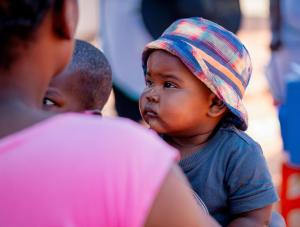Immunization outreach gains ground in Zimbabwe
Kadoma - Nine-year-old Mavis** from rural Sanyati was looking forward to a joyful December holiday, filled with games and laughter with her siblings. But those plans came to an abrupt halt when she woke up one morning unable to walk.
Panicked and unsure of what to do, her family turned to their faith, seeking a miracle at a local church. After two weeks of fervent prayers but no improvement, church leaders advised her parents to seek medical help.
Mavis was admitted at Kadoma District Hospital, where a series of tests revealed a polio diagnosis, a disease that many in her community thought had been relegated to the past.
Her mother, 29-year-old Patricia Phiri, admitted that Mavis had received only one dose of the polio vaccine. “With long days at the farm, it was hard to make time for clinic visits. I never imagined my daughter could get polio, I had only heard of it in passing,” she said.
Thanks to early detection and support from health workers, Mavis began treatment and physiotherapy. With consistent follow-up, including home visits, she gradually regained her ability to walk. Her recovery, though partial, brought relief and a renewed sense of awareness to the family.
“My child’s illness taught me a lesson. I now understand how critical it is to make time for immunization, no matter how busy life gets,” Patricia said. “I want other parents to learn from our experience that immunization save lives.”
Mavis’ case came to light just a month after Zimbabwe’s environmental surveillance system detected poliovirus in sewer wastewater, an early warning signal of the virus silently circulating. This triggered an urgent national response led by the Ministry of Health and Child Care (MoHCC), in collaboration with the Global Polio Eradication partners including World Health Organization (WHO), BMGF, UNICEF, Rotary International and CDC.
Zimbabwe launched four rounds of vaccination campaigns using the novel oral polio vaccine type 2 (nOPV2), reaching over 5 million children under the age of 10. These nationwide efforts, conducted through schools, door-to-door outreach, health centers and mobile clinics, played a pivotal role in containing the outbreak and maintaining the country’s polio-free status.
Now, as Zimbabwe joins the region in marking African Vaccination Week, the nation reflects on hard-earned lessons and renewed determination to strengthen immunization services, from innovative surveillance systems to expanded outreach and a growing culture of vaccine acceptance.
The country has long maintained a robust routine immunization programme, delivering essential vaccines through public health facilities, mobile outreach clinics, and school-based initiatives. The country is part of the Global Polio Eradication Initiative and has sustained high vaccination coverage over the years, with over 90% of children receiving key vaccines, including polio.
But the fight is not without its challenges. Geographical barriers, religious and cultural beliefs as well as socio-economic pressures can lead to children being missed. In rural areas like Sanyati, limited access to healthcare facilities and poor road infrastructure makes it difficult for families to complete routine immunization schedules.
“Here in Sanyati, integrated outreach services are now making a big difference,” said Alexio Denhere, the Community Nurse-in-Charge for Sanyati District. “We have seen an increase in the number of parents bringing children for immunizations, especially since the community became aware of Mavis’ case.”
In recent years, Zimbabwe has strengthened both its immunization delivery systems and surveillance mechanisms to prevent and respond to any potential polio outbreak.
One of the country’s major milestones was the establishment of a state-of-the-art Environmental Surveillance (ES) laboratory in March 2025 within the National Polio Laboratory in Harare. Supported by WHO through funding from the Gates Foundation, the ES laboratory allows for detection of poliovirus in wastewater, a crucial tool for identifying virus circulation even before clinical symptoms emerge.
Since launching environmental surveillance in 2023, Zimbabwe has expanded from 4 to 9 monitoring sites. The system detected 32 isolates of circulating vaccine-derived poliovirus type 2 (cVDPV2) in wastewater samples and helped guide targeted responses to limit further spread.
In parallel, Zimbabwe maintains an active Acute Flaccid Paralysis (AFP) surveillance system. This involves detecting and investigating sudden paralysis in children, a hallmark sign of polio to ensure no case goes unnoticed. The surveillance network works hand-in-hand with environmental monitoring to ensure comprehensive national coverage.
At the forefront of this work are the village health workers, community mobilizers, environmental health practitioners, nurses, and community health workers who serve as the first line of defense in both prevention and response. They work tirelessly to counter misinformation, track zero-dose children and engage families on the importance of vaccination.
Routine immunization services have been strengthened through electronic tracking systems, child health card distribution, and community feedback mechanisms. These efforts have enhanced data quality, allowed timely follow-ups and reduced the number of children falling through the cracks.
“The country’s commitment is evident in its proactive surveillance, timely response, and dedication to reaching every child,” said Dr. Desta Tiruneh, WHO Representative to Zimbabwe.
While the country remains on high alert against any re-emergence of the virus, its integrated approach spanning prevention, detection, response and engagement of communities is paving the way toward a polio-free future.
For children like Mavis, this work means more than statistics.
**Name changed to protect identity of the child
